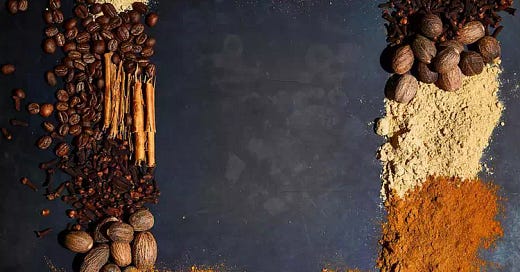Ever since Starbucks first marketed their pumpkin spice latte in 2003, pumpkin spice has been a staple of autumn in the US and many other countries. Most people can be divided pretty evenly between, “I look forward to my first pumpkin spice latte every year” and “meh, it’s fine;” with a few outliers such as those who don’t care for pumpkin in any form (my best friend is married to one such individual, and I always feel sad for him this time of year), and those who can be blamed for such atrocities as pumpkin spice Pringles, pumpkin spice salmon, and pumpkin spice kitty litter (yes, those are all real products. No, I have not tried them). But, even if you have grown rather weary of the pumpkin spice mania that has gripped the nation for twenty years now, don’t knock it. There are good reasons why pumpkin and pumpkin pie spices are associated with fall, and they don’t even include how amazing they taste when combined with coffee.
Pumpkin has a great many medicinal benefits, including lowering “bad” cholesterol and increasing “good” cholesterol, boosting your immune system, and improving your eyesight and skin resilience. Like other orange vegetables, pumpkin is high in beta carotene, an antioxidant that is transformed into Vitamin A in your body, which is healthy for your eyes and skin and can lower your risk of some types of cancer, such as lung and prostate cancer. Pumpkin flesh and seeds is also high in potassium, which helps regulate your blood pressure, and fiber, which helps regulate other things; fiber, potassium, and vitamin A all contribute to heart health as well. And pumpkin seeds contain tryptophan, an amino acid that aids the body in producing serotonin, which is essential for sound sleep1. All of these medicinal benefits are especially important in the winter, when your immune system is beset by a noxious cocktail of seasonal ills, dry air assaults your skin, the closed-in nature of life in the colder months means your eyes are not getting the rest of distance vision that can only be gained outside, decreased activity levels can lead to sluggish bowels and reduced circulation, and the increased darkness prompts your body to require more and deeper sleep.
The magical properties of pumpkin are no less beneficial, especially in the cold, lean months. The bounty of fat seeds contained in each pumpkin makes it ideal for prosperity and abundance magic. Thanks to the long association with Jack’o’lanterns, pumpkins are also associated with protection, which makes a bowl of pumpkin soup or a cup of pumpkin spice tea or coffee especially comforting on those bitterly cold days. Besides the obvious association with the harvest, pumpkins are also associated with generosity, gratitude, potential, and creativity. Few non-religious holidays embrace gratitude and generosity as much as Thanksgiving, and pumpkin has long been a staple of the day. It’s abundance of seeds symbolizes potential for wild growth (as anyone who has ever thrown a pumpkin into the compost pile and been surprised the following summer by jubilant green vines can testify!), and even people who don’t consider themselves creative can be challenged to rise to the occasion when faced with a pumpkin and a carving knife. It’s long shelf life not only makes it an ideal squash for winter eating, but also a stable addition to money and prosperity magic. The high water content of pumpkins (between 82% and 95%, depending on the variety2) means that it is closely associated with the water element, the moon, and feminine energy/divinities. Also, and this goes without saying, the lumpy and brightly colored fruit is just downright charming. Pumpkins always make me want to smile.
Pumpkin spice is much older than the latte for which it is named; in fact, the blend dates back to the 17th century and it’s origination with the Dutch East India Company (although some accounts claim that the first known use of the blend was in Greece 1000 years ago). The blend was introduced into the New World in 1796, where it was used in a recipe for “pompkin pie” in a cookbook written by Amelia Simmons, the first cookbook to be written by an American3. Traditionally, pumpkin pie spice is a blend of cinnamon, ginger, nutmeg, allspice, and cloves; although not all blends contain all five spices, and some include a bit of finely ground black pepper (mine does). Pumpkin spice is as hot as pumpkin is cool, so they balance out nicely. All of the spices used in pumpkin spice are associated with fire and masculine energy.
Keep reading with a 7-day free trial
Subscribe to CrossWitch to keep reading this post and get 7 days of free access to the full post archives.




